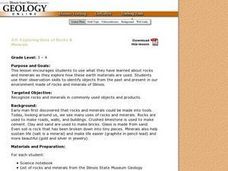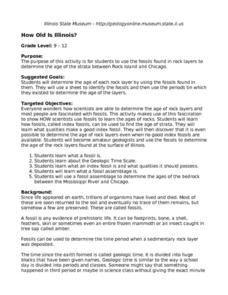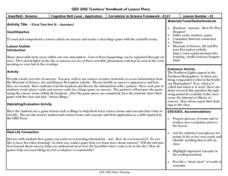Curated OER
Germs Can Make You Sick
Learners explore how germs are spread. In this science lesson, students practice good hand washing practices and discuss how washing hands can prevent the spread of germs.
Curated OER
Eyewitness Dinosaur Video Quiz
In this science worksheet, students use their notes from the Eyewitness video on dinosaurs to help them select the correct answer for each question. They identify various types of dinosaur fossils found and their specific names.
Curated OER
Water: H2O = Life
In this earth science worksheet, students explore and describe animals and their adaptations, including their habitats, physical characteristics, and competing organisms. They also explore and describe how others use water around the...
Curated OER
Toothpick Worms
Students investigate camouflage. In this science lesson plan, students experience the role of color in camouflage as they complete a hands-on activity.
Curated OER
The Hall of Physicist
Students study the history and scientific contributions of Albert Einstein. In this Albert Einstein lesson plan, students learn his history, research his scientific contributions, create a timeline of him and his work, and create a...
Curated OER
Exploring Photographs, Lesson 2—A Closer Look: Analysis in the Museum
Students explore photographic works of art. In this visual arts instructional activity, students analyze selected photographs by Garcia, Ray, and Eggleston. Students take their own photographs in the style of these photographers.
Curated OER
A Dinosaur Scavenger Hunt
Students explain what a fossil is, learn six dinosaurs and tell one characteristic about each, then describe verbally what a dinosaur might have looked like.
Curated OER
Animals in Art
Second graders demonstrate visual awareness by listing seven to nine types of animals shown in the artwork on the tour. They draw three types of textured lines or patterns shown in the tour artwork and model an imaginary animal using clay.
Curated OER
4.5: Exploring Uses of Rocks & Minerals
Students, in pairs, use observation skills to identify objects from the past and present in our environment made of rocks and minerals of Illinois.
Curated OER
How Old Is Illinois?
Students use fossils found in rocks to determine the age of rock in Illinois. They use a chart to identify the fossils and then identify the periods of rock.
Curated OER
Visit to Ackland Art Museum (African Masks Exhibit)
Second graders observe and describe the similarities and differences in the African Mask exhibit at the Ackland Art Museum. They use describing words to express the feelings of the masks.
Curated OER
Swords, Arrows, and Eggs
Students enjoy hands-on learning experiences. In this current events instructional activity, students may visit the Lulworth Castle, Roald Dahl Museum, Glasgow Science Centre, Salts Mill, or the Sherwood Forest online or in-person to...
Curated OER
Science
Third graders study light and shadow, participate in mirror activities, and build a periscope.
Curated OER
Tucson Children's Museum Dino Crossword
In this crossword puzzle, middle schoolers complete a crossword puzzle related to dinosaurs, the era in which dinosaurs lived, and about other animals that lived during that time period.
Curated OER
First You See It - Auroras!
Students read science article on auroras and create a class bingo game with the scientific terms.
Curated OER
Global Warming Webquest - Group Worksheet
In this global warming learning exercise, students, working in groups, answer 11 discussion questions involving global warming, climate, greenhouse effects and ecosystems.
Curated OER
Are You an Energy Efficient Consumer?
In this energy consumption worksheet, students use on line resources to explore the energy use by different countries around the world. Students compare the amount of light emitted by different countries and their carbon dioxide...
American Museum of Natural History
Being a Conservation Biologist: Eleanor Sterling
Eleanor Sterling responds to 21 questions posed by young learners about the challenges she faces as a woman conservation biologist. She also discusses her research of the aye-aye, an unusual animal that lives in Madagascar.
Curated OER
Exploring Buoyancy
Students use materials found at a resource table to design simple devices that will house instruments to take water samples from a tub of water. They design 3 instruments, each varying in density so that one will float, one will hover...
American Museum of Natural History
Climate Change
It actually is possible to have too much of a good thing when it comes to climate change. A slide show lesson describes how burning fossil fuels contributes to climate change. Individuals read about the scientific process and the...
Baylor College
Gravity and Muscles
Humans are so used to gravity as a force that we don't tend to pay much attention to it on a daily basis. Through a couple simple activities, learners experience changes to their center of gravity and come to the understanding that...
National WWII Museum
A New War Weapon to Save Lives
Young historians view and analyze photos and documents from WWII that are related to blood transfusions and blood plasma. A demonstration of correct and incorrect blood donors visually shows the importance of knowing blood type. After...
American Museum of Natural History
Fascinating Fish
A fish is not just a fish. So many fish in remote places have unique characteristics. Take a trip with an ichthyologist to the Congo River to discover the species of one of the most diverse fish populations in the world. The online...
Curated OER
Free Up the Ketchup!
Learners, in teams, use given materials and their knowledge of Newton's First Law to create a device that will remove a sticky ping pong ball from a 16-oz. cup (which represents ketchup stuck in a bottle.)

























